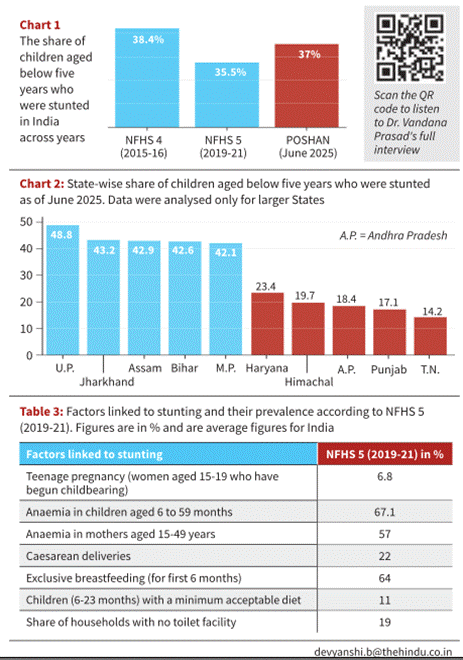Policy Performance Gap
- Target vs Reality: POSHAN Abhiyaan aimed for 25% stunting by 2022, but 2025 data shows 37% – only 1.4% improvement from 38.4% in 2016
- Implementation Failure: Seven years of flagship nutrition program yielding negligible progress despite substantial resource allocation
- Systemic Issues: Minimal progress indicates deeper structural problems beyond program design or funding inadequacy
- Mission 25 Collapse: Ambitious government target becoming policy embarrassment highlighting execution challenges
Relevance : GS 2(Health , Governance)

Root Cause Analysis
- Maternal Health Crisis: Nearly half of stunted children already small at birth, linking stunting directly to prenatal conditions
- Teenage Pregnancy Impact: 7% of women aged 15-19 began childbearing, with adolescent mothers physiologically unprepared for pregnancy
- Educational Correlation: 46% children of uneducated mothers stunted vs 26% for mothers with 12+ years schooling
- Intergenerational Cycle: Poor maternal education perpetuating child malnutrition through inadequate care practices
Nutritional Deficiencies
- Dietary Inadequacy: Only 11% children under two meet minimum acceptable diet standards, indicating massive nutritional gaps
- Carbohydrate Dominance: Rice-heavy diets in poor households, particularly Adivasi communities, lacking protein and micronutrients
- Protein Scarcity: Dal consumption once weekly or monthly in impoverished areas, creating amino acid deficiencies
- Micronutrient Crisis: Limited access to eggs, despite some Anganwadi inclusion, perpetuating vitamin and mineral deficits
Maternal Anemia Epidemic
- Widespread Prevalence: 57% women aged 15-49 anemic, directly impacting fetal development and birth outcomes
- Child Impact: 67% children under five anemic, creating compounding malnutrition effects
- Iron Deficiency: Maternal anemia during pregnancy compromising infant growth potential from conception
- Healthcare Gap: Insufficient antenatal care and nutrition supplementation programs for pregnant women
Breastfeeding Challenges
- C-Section Disruption: Surgical deliveries increasing from 9% (2005-06) to 22% (2021), interfering with immediate breastfeeding
- Colostrum Loss: Babies missing first milk containing essential nutrients due to medical separation post-delivery
- Class Disparities: Government teachers getting six months maternity leave vs domestic workers returning within two weeks
- Exclusive Breastfeeding: Only 64% babies under six months exclusively breastfed, well below optimal standards
Sanitation & Hygiene Crisis
- Open Defecation: 19% households still practicing open defecation, contaminating groundwater and spreading infections
- Gut Health Damage: Unsafe water disrupting bacterial balance needed for nutrient absorption
- Infection-Malnutrition Cycle: Malnourished children falling sick more frequently, eating less, absorbing less nutrition
- Environmental Contamination: Poor sanitation creating disease burden preventing proper growth
Socioeconomic Determinants
- Poverty Trap: Stunting correlating with reduced cognitive abilities, educational attainment, and employment prospects
- Intergenerational Poverty: Malnourished children becoming disadvantaged adults, perpetuating family deprivation cycles
- Urban-Rural Divide: Different challenges across geographic and economic contexts requiring targeted interventions
- Caste and Community: Adivasi and marginalized communities facing disproportionate malnutrition burdens
Healthcare System Failures
- Antenatal Care Gap: Inadequate prenatal monitoring and nutrition counseling during critical fetal development period
- NICU Separation: Medical protocols inadvertently disrupting mother-child bonding and breastfeeding initiation
- Skill Deficits: Healthcare workers lacking comprehensive nutrition counseling capabilities
- Follow-up Weakness: Poor tracking of high-risk mothers and children through critical growth windows
Policy Recommendations
- Holistic Approach: Addressing maternal education, healthcare access, sanitation, and economic empowerment simultaneously
- Targeted Interventions: Special focus on teenage pregnancy prevention and adolescent girl nutrition programs
- Dietary Diversification: Expanding protein and micronutrient access through local food production and distribution systems
- Breastfeeding Support: Workplace policies enabling extended maternity leave across all employment categories
Long-term Implications
- Human Capital Loss: Stunted generation creating permanent economic disadvantage and reduced national productivity
- Healthcare Burden: Malnourished children requiring higher medical interventions throughout life
- Development Goals: Stunting crisis undermining broader sustainable development objectives and demographic dividend potential
- Global Standing: India’s malnutrition rates affecting international perception and development partnership opportunities



